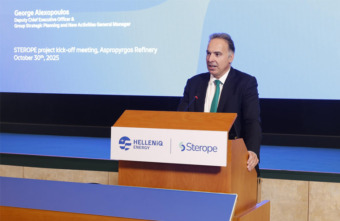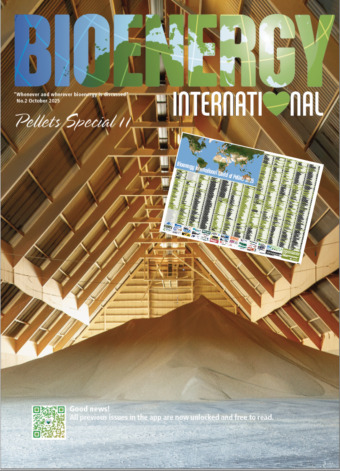Funded under the Horizon Europe Programme, the recently launched Synergistic Advanced Carbon Capture Technologies for ConvERsion of Industrially Emitted CO₂ to sustainable Production of biofuels and chEmicals (STEROPE) project aims to transform industrial carbon dioxide emissions into sustainable fuels for aviation, maritime, and chemicals through innovation, industrial symbiosis, and real-scale refinery integration.
Led by HELLENiQ ENERGY (Greece), this four-year initiative unites 16 European partners from eight countries in a multidisciplinary effort to accelerate industrial decarbonisation, strengthen Europe’s technological leadership, and advance its transition towards climate neutrality.
The Synergistic Advanced Carbon Capture Technologies for ConvERsion of Industrially Emitted CO₂ to sustainable Production of biofuels and chEmicals (STEROPE) project that will demonstrate how advanced carbon capture and utilisation (CCU) technologies can transform industrial carbon dioxide (CO2) emissions into sustainable aviation fuels (SAF), renewable marine fuels, and bio-based chemicals, using green hydrogen and innovative catalytic and membrane systems.
By converting CO2 emissions from refineries and other hard-to-abate sectors into renewable fuels, the project provides tangible solutions for reducing greenhouse gas (GHG) emissions while reinforcing industrial competitiveness, strategic autonomy, and job preservation across Europe.
The initiative directly contributes to the goals of the European Green Deal, the Fit-for-55 package, and the EU Industrial Strategy, supporting the transition towards net-zero emissions by 2050 and reducing dependence on imported fossil energy.
The energy transition demands commitment and coordinated action. Through STEROPE, we are transforming CO2 from a liability into an opportunity—developing technologies that decarbonise operations and create new European value chains in hydrogen and sustainable fuels, stated George Alexopoulos, Deputy CEO and Group Strategic Planning & New Activities General Manager at HELLENiQ ENERGY.
A new paradigm of carbon circularity
STEROPE will implement a first-of-its-kind TRL 7 demonstration at the Eleusis refinery (Greece)—a fully operational industrial site—where three complementary CCU prototype units – capture, conversion, and synthesis – will be designed, constructed, installed, and operated under real refinery conditions.

This large-scale integration represents a turning point for industrial CCU deployment in Europe, demonstrating the technical and economic viability of decarbonising existing assets rather than replacing them.
A digital-twin platform will continuously optimise performance, energy efficiency, and environmental impact, maximising the use of renewable electricity and system flexibility.
By coupling CO2 valorisation with renewable hydrogen and advanced catalytic conversion, STEROPE will showcase how Europe can close the carbon loop and redefine the future of its industrial base.
STEROPE will:
- Demonstrate the conversion of industrial CO₂ emissions into SAF and renewable marine fuels
- Design, build, and operate a TRL 7 demonstration plant fully integrated into a working refinery
- Advance circular economy and industrial symbiosis principles for resource efficiency.
- Conduct LCA, TEA, and social-impact assessments to ensure sustainability and scalability.
- Support regulatory validation of SAF and marine fuels for real market applications.
A European powerhouse of innovation
Coordinated by HELLENiQ ENERGY (Greece), the STEROPE consortium brings together sixteen partners from eight European countries, combining industrial expertise, academic research, and technological innovation.
Bridging industrial R&D with real-world deployment is crucial. STEROPE unites Europe’s top expertise to convert CO2 emissions into sustainable fuels—an essential step for sectors such as aviation and maritime, where electrification is not yet feasible, noted Dr Spyros Kiartzis, Manager of New Technologies and Alternative Energy Sources at HELLENiQ ENERGY.
The partnership includes leading institutions such as the Instituto de Catálisis y Petroleoquímica ICP-CSIC (Spain), Centre for Research and Technology Hellas – CERTH (Greece), Centre for Renewable Energy Sources and Saving Foundation – CRES (Greece), Universiteit Gent (Belgium), the Faculty of Technology and Metallurgy of the University of Belgrade (Serbia), and the Università degli Studi di Genova (Italy), alongside industrial and innovation actors including the Spanish Technology and Innovation Platform on Biocircularity – BIOPLAT (Spain), Aegean Airlines (Greece), DANAOS Shipping Company Limited (Cyprus), Maturus OptimI BV (Netherlands), Analisis-DSC Dynamic & Security Computations SL (Spain), Ercros S.A. (Spain), Moravacem (Serbia), Cranfield University (United Kingdom), and the Cyprus Marine and Maritime Institute (Cyprus).
This multidisciplinary alliance brings together expertise in CCU, hydrogen technologies, catalysis, process engineering, digital optimisation, and sustainability assessment, ensuring that the technologies developed are both innovative and commercially viable, while addressing Europe’s environmental, energy, and industrial challenges.
Towards Europe’s next generation of clean fuels
At the kick-off meeting held at the end of October 2025 in Athens, Greece, partners outlined the roadmap for the first implementation phase and joint research priorities.
The event featured the participation and support of Maria Georgiadou, Senior Policy Officer at the European Commission’s DG Research and Innovation (DG RTD), who highlighted STEROPE’s strategic importance as a lighthouse initiative for Europe’s transition to a circular, climate-neutral industrial economy.
STEROPE reflects Europe’s shared ambition to transform industry through science and collaboration. By demonstrating CCU technologies directly in an operating refinery, we bridge innovation with reality—turning research into impact, and emissions into resources, concluded Eva Nanaki, Project Coordinator and Innovation Analyst at HELLENiQ ENERGY.



